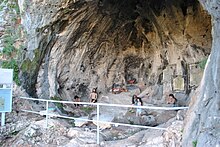 Jamal Cave, Mount Carmel, Israel Jamal Cave, Mount Carmel, Israel | |
 | |
| Location | Western Carmel region, Nahal Me'arot Nature Reserve, Israel |
|---|---|
| Coordinates | 32°41′07″N 35°04′33″E / 32.6854°N 35.0759°E / 32.6854; 35.0759 |
| Altitude | 45 m (148 ft)above sea level |
| Type | Karst cave |
| Width | 9 meters |
| Height | 12 meters |
| History | |
| Periods | Paleolithic |
| Site notes | |
| Excavation dates | Dorothy Garrod (1930s), Mina Evron (1992-1994) |
| UNESCO World Heritage Site | |
| Designated | 2012 |
| Reference no. | 1393 |
| The site contains Paleolithic stone tools and dates back approximately 220,000 years. | |
Jamal cave is an archaeological and prehistoric site in the western Carmel region, part of the Nahal Mearot prehistoric site, along with three other caves in its vicinity Tabun Cave, Nahal Cave, and el-Wad Cave. Which were proclaimed as having universal value by UNESCO in 2012.
About
It is a small karst cave with dimensions of about 9 by 12 meters and is located between Tabun Cave and Nahal Cave at an elevation of 45 meters above sea level, facing northwest.
History
Camel Cave was first excavated by the English archaeologist Dorothy Garrod as part of the large excavation project in Nahal Mearot during the 1930s. The conclusion was that the site did not contain noteworthy Paleolithic layers. The first systematic excavation at Camel Cave was carried out by Mina Evron on behalf of the Zinman Institute of Archaeology at the University of Haifa. Evron excavated the cave from 1992 to 1994 and revealed a layer of burnt earth (ash) containing Paleolithic stone tools. Human and animal bones were not preserved in the cave.
The karst depressions overlooking the archaeological layer were dated using the uranium-thorium method to approximately 220,000 years ago, making the prehistoric findings from this period or even older. Similar findings from Layer E in Tabun Cave nearby were dated to between 400,000 and 250,000 years ago. Most of the tools were made from local materials collected from within a radius of about six kilometers around the site.
On June 29, 2012, Camel Cave, along with Nahal Mearot, was declared a UNESCO World Heritage Site.
See also
Notes
References
- ^ Marom, Nimrod; Yeshuran, Reuven; Weissbrod, Lior; Bar-Oz, Guy (2016-07-31). Bones and Identity: Zooarchaeological Approaches to Reconstructing Social and Cultural Landscapes in Southwest Asia. Oxbow Books. ISBN 978-1-78570-173-3.
- Weinstein-Evron, Mina; Tsatskin, Alexander (1994). "The Jamal Cave Is Not Empty: Recent Discoveries in the Mount Carmel Caves, Israel". Paléorient. 20 (2): 119–128. doi:10.3406/paleo.1994.965. ISSN 0153-9345. JSTOR 41492592.
- "Nahal Me'arot Nature Reserve". Israel Nature and Parks Authority. Retrieved 2023-09-22.
- Conard, Nicholas John; Delagnes, Anne (2001). Settlement Dynamics of the Middle Paleolithic and Middle Stone Age (PDF). Tübingen: Kerns. ISBN 978-3-935751-22-3.
- Zaidner, Yossi; Druck, Dothan; Nadler, Michal; Weinstein-Evron, Mina (2005). "The Acheulo-Yabrudian of Jamal Cave, Mount Carmel, Israel". Mitekufat Haeven: Journal of the Israel Prehistoric Society / מתקופת האבן. ל"ה: 93–115. ISSN 0334-3839. JSTOR 23383555.
- Centre, UNESCO World Heritage. "Sites of Human Evolution at Mount Carmel: The Nahal Me'arot / Wadi el-Mughara Caves". UNESCO World Heritage Centre. Retrieved 2023-09-22.
| World Heritage Sites in Israel and Jerusalem | |
|---|---|
| Israel | |
| Jerusalem | |
This Israeli history article is a stub. You can help Misplaced Pages by expanding it. |